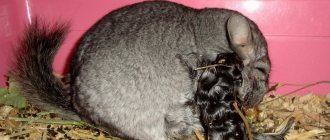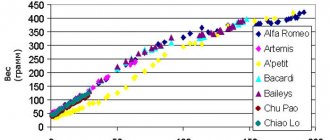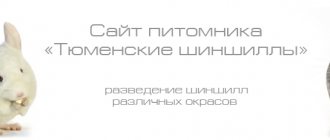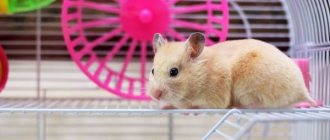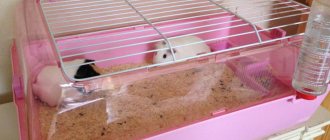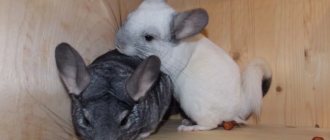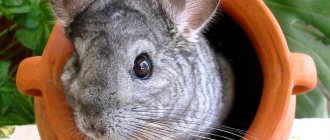This article will talk about breeding chinchillas at home and the rules for giving birth.
On the one hand, this is a profitable business that does not require large upfront costs, on the other hand, it is an exciting hobby. Indeed, today these animals are considered not only as a source of valuable fur, but also as pets, which are often bought for city apartments or private houses. But before breeding chinchillas, you should familiarize yourself with special literature, study the features of their maintenance, breeding, raising young animals and take care of creating the necessary conditions.
How is childbirth?
Normally, chinchillas give birth very quickly.
The female usually gives birth to from 1 to 4 puppies, and the entire period of labor lasts from several minutes to 2-2.5 hours. After the placenta appears, the chinchilla eats it. If there are no deviations during the process, the animal does not require assistance. Excessive touching, examination, or attempts to stimulate the puppies to move through the birth canal can cause stress in the female, which blocks the production of oxytocin and stops contractions. Labor disturbances occur in chinchillas that are too young or injured, as well as in individuals with abnormal presentation of one or more fetuses. Often difficult births occur in females who were previously used for breeding and were forced to produce offspring more than twice a year. If you suspect the development of any abnormalities, you should contact your veterinarian.
If your chinchilla has already had labor disorders, you should arrange in advance with the veterinarian for a home visit.
Signs of approaching labor
The fact that the female is preparing for childbirth can be understood by her behavior. The chinchilla begins to build a nest: she chews the bedding to make it softer and folds it in the most closed corner. Some animals pluck fluff from their belly and sides, also lining their nest with it. Preparing the place for delivery usually lasts 2-4 days. The female gradually becomes less active, lies on her back most of the day, stops eating and practically does not move. This behavior is normal and should not be a cause for concern. It is worth considering that during control weighing immediately before birth, the chinchilla’s body weight can decrease by 15-25 grams.
A few days before giving birth, the female begins to stretch or sag. This helps move the babies towards the birth canal.
Not only the behavior, but also the appearance of the female changes. Due to the movement of the puppies towards the exit from the pelvis, the chinchilla’s stomach drops, the sides fall in, and the genitals become more pronounced and swollen. When measuring rectal body temperature, a decrease of 1-1.2°C is noted.
How to prepare for giving birth to a chinchilla?
After mating chinchillas, you need to mark the date on the calendar and count 105-115 days from it in order to prepare in advance for the expected date of birth. In a specially kept notebook, data on measurements of the female’s body weight, features of her behavior during gestation, and some important points or troubling questions should be recorded. If your pet is restless, eating poorly, or gaining weight, you should consult your veterinarian in advance. His number must be saved in your phone or written down in a notebook when monitoring a pregnant female.
For the day of birth, it is recommended to prepare clean diapers, hydrogen peroxide, sterile syringes, saline solution and milk replacer. The female should have clean water in sufficient quantities in her cage.
During childbirth, you should keep disposable diapers or soft wipes on hand. During multiple pregnancies, you can help the female by gently wiping the newborn babies with them.
How to help a chinchilla during childbirth?
Most often, chinchillas give birth in the morning, around 5-7 am. In the normal course of the process, the puppies will already be born at 9-10 o'clock. About a day after giving birth, the female will begin lactation. Before this, colostrum is released from the nipples. It is whitish in color and nutritious enough to provide the cubs with the necessary substances in the first 24 hours.
The female should be helped during childbirth if there is a suspicion of a pathological course of the process. At the same time, the chinchilla behaves restlessly, squeaks, or, on the contrary, reacts sluggishly to external stimuli due to loss of strength. You should consult a doctor if labor lasts more than 5-6 hours, if there is heavy bleeding from the genital tract or if contractions stop. In this case, surgical intervention is necessary, that is, a caesarean section.
If childbirth is going well, then there is no need to interfere with the process.
Preparing for childbirth
The approach of childbirth in a chinchilla can be judged by several signs. The most important thing is that the female shows unreasonable anxiety and becomes restless. If the male is not resettled by this point, the expectant mother will begin to attack him.
Also, by the time labor begins, the chinchilla will begin to build a nest. To do this, she will drag straw to the chosen place and pull out her own wool, which will act as “insulation.” At the time of building the nest, the pregnant female becomes very tired, so she will sleep more often and lie on her back.
Shortly before the planned date of birth, you will need to perform several mandatory actions:
- remove the male;
- cover the cage with the female with a breathable cloth;
- fill the drinking bowl with fresh water;
- If there are recommendations from a veterinarian, prepare the necessary medications in advance.
If the chinchilla did not take care of arranging the nest before giving birth, you will have to help her. To do this, it is enough to buy a warm house or insulate your pet’s favorite place with chopped straw.
If the pregnancy was difficult, you can arrange in advance for the presence of a veterinarian at the birth to be on the safe side.
Chinchillas are in heat
Exotic rodents can only be mated during the female chinchilla’s estrus period, which repeats every 30 to 45 days. The frequency of this phase of the sexual process depends on the individual characteristics of the female; the minimum cycles consist of 20 days; with the maximum cycle, estrus repeats after 60 days. The reproductive cycle of a female chinchilla consists of three stages, which can be determined by the behavior of the partners towards each other.
Excitation stage of the sexual cycle
Duration 1-3 days, consists of sexual arousal, estrus, heat and ovulation. The female's loop opens, the male is actively interested in the female, the female accepts courtship, and the animals mate. Ovulation occurs 12-24 hours after estrus; the outcome of this stage will be conception with successful mating or the inhibition stage.
Braking stage
The female's loop closes, the female shows indifference to the male, during this period it is necessary to diagnose the female's pregnancy by weighing and detecting vaginal plugs in the form of white paraffin flagella 2-3 cm in size. In the absence of conception, the balancing stage begins.
Vaginal plugs
Equilibration stage
Lasts until the next stage of arousal of the sexual cycle, the female’s loop is closed, both partners have a balanced attitude towards each other.
Chinchillas begin estrus at the age of 4-8 months. With early maturation, the first estrus can be observed in a 3-month-old female, with late maturation - after 12 months. It is highly not recommended to breed furry animals during a female's first estrus. The female's body needs to get stronger and prepare for the reproduction of offspring, so it is better to wait out the first heat.
Chinchillas' estrus lasts 2-3 days. During this period, ovulation occurs in the female’s body, accompanied by the production of thick mucus to improve the advancement of sperm and the final attachment of fertilized eggs to the wall of the uterus. The female's loop opens only during the period of estrus and childbirth; it is during these periods that the female can be covered by the male. The rest of the time, the female’s genitals are closed to prevent external infections. The owner of a chinchilla needs to be able to determine the onset of the next estrus in a female to successfully plan the breeding of the furry animals.
General recommendations
Sexual maturity in females occurs at approximately 6-7 months, in males somewhat later - at approximately 9 months. Some chinchillas come into heat quite early, at 3-4 months, but it is recommended to mate the animals only after reaching a year. By this moment, the female has reached the size necessary for normal bearing of offspring. Early birth can cause physical damage to the health of a chinchilla and make it aggressive towards the male and cubs.
It should be taken into account that in order to give birth to healthy and strong offspring, both the male and the female must be healthy and strong. Mating of exhausted or weak animals is fraught with the death of the chinchilla during childbirth or the production of sick and non-viable puppies.
To reproduce, rodents need to form a pair. A healthy female, 12 months of age or older and weighing at least 0.5 kg, must be placed in a cage with a male. It is recommended to select a male who is 2-5 months older. At the same time, chinchillas can exist both in monogamous pairs, which consist of one female and a male, and in polygamous groups formed by a male and several females. In the second case, each animal must live in its own enclosure.
Healthy, large, sexually mature individuals are allowed to reproduce
The female and male can live together or separately. If you plan to place rodents only for the mating period, you should choose the most appropriate moment. The chinchilla's reproductive cycle lasts approximately 28-29 days. At the same time, estrus continues for about 3-4 days, during which the female secretes a special secretion.
A few days before this period, the animals should be placed in one enclosure. When rodents are ready to breed, their behavior changes: the male becomes playful and chases the female around the cage, making cooing sounds. At the same time, the female behaves restlessly, moves a lot, scatters food and sand around the enclosure. A characteristic sign of readiness for mating is the enlargement and hyperemia of the chinchilla’s genitals.
Seated female and male
After placing the rodents, it is recommended to keep a diary or calendar in which you need to note the periods of estrus in the female and the expected dates of mating of the animals. This will allow you to estimate the approximate date of birth of the offspring and prepare in advance for childbirth.
How to care for a pregnant chinchilla
To successfully complete the birth, a pregnant chinchilla needs the following conditions:
- an enclosure free of toys and shelves to avoid injury to newborns. Instead of an enclosure, a low cage with a gap of 10 mm between the bars is suitable (so that the cubs do not end up outside);
- protection from noise and harsh light, plus maintaining silence in the room;
- reduction of walks. It is not recommended to pick up an animal. If necessary, the owner can calm the female by stroking her belly. It is forbidden to lift a chinchilla by the tail, as fright from this can lead to miscarriage;
- placing the male a few weeks before birth;
- X-rays during the prenatal period (contraindicated in shy individuals);
- daily cleaning and flooring made of wood or hay to insulate the floor;
- no swimming three to four days before the event and the next few weeks;
- cleaning the enclosure a couple of days after a successful outcome.
https://youtube.com/watch?v=sJxtXDzCqmM
Birth of puppies
Immediately on the day of delivery, the chinchilla becomes very restless. She flinches at every rustle, refuses to eat and sits in the prepared nest. When childbirth occurs, the female stands on her hind legs, resting her front legs on the bars of the cage. In this position it is easier for her to push the babies out.
As the puppies emerge, the female licks them and eats the afterbirth. Since the cubs can quickly freeze and get sick with wet coats, they immediately hide under their mother’s warm tummy. If a dead puppy is found, it will need to be removed immediately. Otherwise, the woman in labor may experience stress and refuse to feed the rest of the babies.
A few hours before giving birth, a chinchilla may experience so-called false contractions. During this process, she stands on her hind legs, her ribs are strongly retracted, and her stomach contracts.
As a rule, healthy females cope with the birth process on their own. After which they quickly recover. However, you should not place a male with a young mother for another 5-6 months - this period of time is necessary to fully restore strength and prepare the body for a new pregnancy.
How to breed chinchillas: raising young animals
- If the birth went well, there are no postpartum complications, the first weeks after birth the cubs feed only on mother's milk. It contains all the necessary nutrients for their development and antibodies for the formation of reliable immunity.
- The amount of milk in a healthy female depends on what food she receives, so the female should be provided with the highest quality food. Towards the end of the first month, chinchilla babies begin to try solid foods, although milk is still their main food.
- Babies are separated from the female at the age of two months, when they are already fully accustomed to feeding on their own. With a large litter, chinchillas are removed gradually, starting with the largest and strongest. So that the female’s lactation gradually decreases and mastitis does not form.
- Some individuals can reach sexual maturity as early as four months, so by this age females and males are placed in separate cages to avoid accidental covering.
- By the age of six months, the main development of the cubs ends, they are covered with full fur and you can decide what to do with them next - offer them for sale or select a pair for them in order to breed chinchillas again from a new pair.
If artificial feeding is necessary
How many babies does a chinchilla give birth to?
Depending on the age of the expectant mother, she can bring a different number of puppies. Older females can give birth to more cubs than younger females. So, an older individual gives birth to about 5-6 puppies, but a young one can give birth to 1 to 3 chinchillas.
Important. It is necessary to understand that if there were more than three puppies in the litter, the rest will need to be supplemented, because the mother most likely will not have enough milk for all of them. For feeding, use a glass pipette or syringe. Cow's and goat's milk is used as a top dressing, as well as, perhaps, diluted condensed milk.
An important question about offspring
It is worth thinking about why an animal in captivity produces fewer offspring than when living in the wild. Most likely, this is influenced by the following factors:
- When living at home, rodents spend most of their time in confined spaces. It is simply impossible to reproduce normally in cramped conditions.
- Often the animal receives an insufficiently balanced diet. Excessive consumption of proteins or fats leads to a decrease in the number of offspring and also affects the survival rate of puppies in the first month of their life.
Reference. In a year, a female can bring cubs up to three times.
Interesting things about offspring
- The animal reaches sexual maturity at 6–7 months.
- The duration of pregnancy is 106–114 days.
- The lactation period lasts on average 40–60 days.
- The female has three pairs of working nipples, this is enough to freely feed three babies.
- On days 5–7 of life, small chinchillas begin to eat food.
- A healthy chinchilla gives birth to puppies on its own without human assistance.
Reference. If you are planning further breeding of these rodents, you need to leave the strongest and most fertile individuals with good hair for the tribe.
Source
Caring for a pregnant female
In the first few weeks, the female’s nutrition and care do not change; everything happens as usual.
As soon as the first signs of pregnancy become obvious, the daily diet is increased by 10 - 20%, and from the second half of the term - by 25%. Be sure to give expectant mothers rolled oats, good hay and green raspberry and nettle leaves.
Simultaneously with the general increase in the amount of feed, it is necessary to provide for an increase in protein food by 15 - 18%. The diet should also contain calcium. This problem can be solved with the help of special drugs, for example, calcemin.
The diet of pregnant rodents does not change. Food is also given once a day, at the same hours.
Pregnant females should be able to move freely. The period of sleep may become longer. The cage is kept in order in the same manner as before pregnancy, approximately once a week.
During this period, you should not make drastic changes to your usual interior.
What to feed a chinchilla after giving birth
The diet of a lactating female should contain increased amounts of protein and calcium necessary to produce the required amount of milk. The chinchilla must be fed with wheat, oat and barley sprouts, nettle grass, alfalfa, vetch, rose hips, vegetables, fruits and nuts.
The introduction of cottage cheese, skim or powdered milk, kefir, yogurt, sour milk, meat and bone meal, milk granules, vitamins, calcium gluconate and berries into the diet should be mandatory.
Milk production is accompanied by increased thirst of the woman, so the owner must be vigilant and take care of pouring the drink. The feeder and water bowl should be located as close to the nest as possible so that the chinchilla can easily reach the nest.
Selecting a mating pair, caring for a pregnant female and her future offspring, as well as assistance during childbirth is a serious and troublesome job, especially for novice chinchilla breeders. All efforts are compensated at first glance by tiny, touching chinchillas, which are born immediately with soft, delicate fur and open, curious eyes, unlike other mammals.
Symptoms and duration of pregnancy and childbirth in chinchillas4 (79.23%) 26 votes
Pair formation
It is at this age that the reproductive system matures and animals can be distinguished by gender characteristics. In a male, there is a distance of several millimeters between the anus and the penis, but in a female, there is no gap between the vagina and the anus.
Chinchillas are polygamous animals and one male can cover three or four females. When forming pairs, the female is placed next to the male. Let's consider the difficult moment of forming a pair, because in severe cases rodents can seriously injure each other. What do we have to do:
- We place the pair in cages next door for a couple of days;
- Next, we place the animals in a small carrying cage for several hours;
- At this time, we prepare the cage for mutual living, change the filler and carry out general cleaning;
- We launch the first male to prepare and mark the territory;
- And last we launch the female.
This scheme will help avoid conflict situations.
How to tell if a chinchilla is pregnant
In the early stages, pregnancy in these big-eyed animals is practically invisible. Mating occurs at night, and a young primiparous individual may not have a plug at all. For successful mating, partners need to be seated correctly so that there is no mutual aggression and hostility among the animals. A reliable sign that a female has become pregnant is that she has not gone into heat for a month.
Early pregnancy leads to:
- Stopping the development of the female;
- pathologies of embryo development;
- severe pregnancy;
- miscarriages;
- death of cubs at an early age;
- general weakening and health problems in the female.
Characteristic signs of pregnancy in a chinchilla
From the 8th week of a pregnant chinchilla, even a novice breeder will be able to determine the presence of pregnancy
To begin with, you should pay attention to the animal’s nipples. In a non-pregnant animal, they do not stand out and are not felt when stroking the fur.
And already from the fifth week of pregnancy, the nipples of a pregnant female begin to swell, turn red and stand out. In the last weeks before giving birth, white colostrum may be released from the nipples.
Pregnant females have an increased appetite
Increased rodent appetite
A pregnant female chinchilla, like any other animal, has an increased appetite. She drinks and eats much more often, as developing puppies need nutrition, proteins and microelements. This is also one of the signs that the animal is pregnant.
Changing the appearance of the nipples
During pregnancy, the female's nipples stand out from the fur, change their color and become more sensitive. As a rule, lactation occurs from only one pair of nipples. The whitish discharge in recent weeks is called colostrum and is not dangerous.
Animal weight gain
Naturally, if there are embryos, the weight of the chinchilla will increase. The weekly increase can reach up to 15 grams. It is recommended to carry out control weighings every week to monitor the progress of pregnancy and record the scale readings on paper or electronically. It is not recommended to take the animal by the tail for weighing. This can cause premature birth or miscarriage. At a later stage, weighing is no longer performed so as not to expose the female to additional stress.
Abdominal enlargement
The rounding and enlargement of the tummy is clearly evident from the 8th week of pregnancy of the chinchilla. With the further development of pregnancy, fetal movements can be observed with the naked eye. After 90 days, you can already feel the cubs in the mother’s belly with your hand. But in order not to provoke a miscarriage, it is not advisable for owners of furry animals to do this.
Changes in the behavior of a pregnant female
Pregnant chinchillas become less and less active as pregnancy progresses. At the same time, they will be noticeably calmer and more affectionate towards their owner. The animal sleeps more often on its side; in later stages, you can observe the female sitting on her back. Before the onset of childbirth, the female becomes restless, frightened by sharp sounds and shows aggression towards the male.
Ultrasound diagnostics and radiography
Ultrasound diagnostics when an animal becomes pregnant is needed to confirm this fact and exclude obvious pathologies. X-rays are carried out in the later stages of pregnancy to determine the number of cubs, when their skeletons are already ossified. Also at this time they look at the presentation of the fetuses. If you have any questions or concerns, you should immediately contact your veterinarian. You should not give your animal medications on your own without a prescription.
Loop change
Before giving birth, the female's external genitalia become red and increase in size. The male may perceive this as estrus and try to mate with a pregnant chinchilla. And sexual intercourse during pregnancy can cause a miscarriage or other problems during pregnancy. Therefore, it is recommended to place the male in a separate cage for several months a couple of weeks before the expected date of birth.
It is better to disturb a pregnant woman as little as possible
Malposition
The newborn comes out feet first. There is a risk that the baby will suffocate if he gets stuck. The chinchilla will try to pull the baby out on its own, grabbing it with its teeth. In this case, the process runs the risk of being delayed, and the hind legs or tail of the newborn will be damaged. Help the woman in labor. With one hand, use your palm to support the female's stomach, with the other hand, gently pull the baby by the legs and body, twisting him clockwise. There may be injuries, but it is necessary to remove the fetus in order to save the mother chinchilla.
Here is an example of difficult births from the practice of our nursery:
| 11.00 o'clock, morning | The chinchilla began to sit down to give birth, she pushed, but could not give birth. They massaged the abdomen several times. |
| 13.30 | The first baby walked feet first, i.e. from the wrong position. I had to help, pull it out with my hands. The baby later did not survive due to birth trauma. The weight of the newborn is 60 grams. |
| 16.30 | The second baby was born head first. Before this, they did a stomach massage. Newborn weight 60 g. |
| 17.15 | The third baby was born head first. No massage needed. The baby was born in the membrane of fetus, which was removed, the lungs were opened and the chinchilla was dried. The weight of the newborn is 58 g. |
Chinchilla behavior during pregnancy
The behavior of chinchillas during pregnancy directly depends on their temperament and health status. If the female is young, then pregnancy proceeds normally, behavior changes only on the eve of childbirth.
Sudden changes in behavior may indicate:
- Hormonal changes are a temporary phenomenon that does not last longer than 3-4 days.
- Stress or discomfort - in this case, irritation, depression, and chronic fatigue are observed. The female is constantly trying to build a shelter or hiding in the far corner of the cage.
From the experience of owners, the following common behavioral metamorphoses can be identified:
- The female begins not only to eat more, but also actively stores, even if she was not inclined to such behavior before.
- Friendly, sociable females can become territorial and even begin to mark.
- Independent females become more sociable and even intrusive.
Experts advise to be calm about changes in the behavior of pregnant chinchillas if you do not observe any alarming symptoms.
Try not to impose communication and attention on the expectant mother, but willingly respond to her initiative
During normal pregnancy, the female's weight increases gradually. Weight gain is due to the production of additional blood and fluid, the growth of embryos and the accumulation of a protective fatty layer in the mother in the peritoneal area.
The normal weight gain during pregnancy for a chinchilla is 25–30 grams. per month. In the last month, the range may be 30–50 grams. Normal, gradual weight gain is a sign of a normal pregnancy.
If the female is healthy at the time of fertilization, theoretically, pregnancy should proceed without complications. Temporary problems may arise if the female does not receive the required nutrition because the owner does not realize that his pet is pregnant. Other possible complications may be related to the quality of care and the environment:
Miscarriage. Most often it is provoked by problems with the cardiovascular system or the so-called blood conflict. Spontaneous miscarriage can occur at any stage of pregnancy. A special risk group includes females who do not receive adequate nutrition. Severe or prolonged stress can also be a factor that triggers a miscarriage. Injuries, fights, jumping, and falls can lead to spontaneous abortion. If the female has a miscarriage, she eats the premature embryos and placenta. Quite often, traces of blood (stains) are found in the cell.
Calcium deficiency. If there is a lack of calcium in the female, the quality of the coat and claws deteriorates, and problems with teeth may occur. The embryos suffer greatly. Puppies' bones and internal organs do not develop properly, which can lead to intrauterine death or the birth of offspring with physical defects.
Repeated pregnancy immediately after childbirth. Due to physiological characteristics, a female chinchilla can go into heat within 36 hours immediately after giving birth. Repeated pregnancy while nursing newborn offspring can lead to the death of the female and puppies.
Rules for handling newborn puppies
A newborn puppy is fully prepared for life. His eyes are open and his body is covered with fur. Usually, immediately after birth, the cubs crawl under the female’s belly and stay there for some time until their skin is completely dry.
If the puppies are active and do not fight at their mother's nipples, then there is no need to feed them. Another indicator of the condition of newborn chinchillas is weight gain, which must be regularly monitored.
Table 1. Age and weight ratio of chinchilla puppies
| Puppy age | Puppy weight |
| newborn | 30-50 grams |
| 7 days | 45-55 grams |
| 14 day | 65-90 grams |
| 3 week | 75-100 grams |
| 1 month | 120-130 grams |
The weight of newborn puppies should be monitored weekly.
In some litters, puppies may be born with their eyes closed. This happens if babies are born prematurely. If you can’t see a veterinarian, you can help your little chinchilla yourself. Soak a cotton swab or pad in a warm decoction of chamomile or calendula and very carefully stroke from the corner of the eye to the puppy's nose.
The condition of premature and weak cubs must be carefully monitored; stronger brothers can drive them away from the female’s nipples. Lack of food quickly exhausts puppies, so in this case they need to be supplemented with a special milk replacer. You can buy it at a pet store.
Feeding a chinchilla puppy with a milk replacer
Video - Feeding a newborn chinchilla
The video demonstrates the process of syringe feeding a puppy that does not have enough mother's milk. Please note that the mixture must be served carefully so that the baby does not choke.
Pregnancy in chinchillas lasts about four months and in the vast majority of cases ends in an easy and fairly quick birth. During the period of childbirth, it is necessary to provide the female with a safe place, protected from extraneous noise and bright light, in which she can safely produce offspring.
Is it possible to touch newborn chinchillas?
To examine the cubs after birth, you need to thoroughly wash your hands with laundry soap to avoid infection. Any other means leave a smell that the mother will perceive as foreign, and there is a danger that she will stop feeding the children or even bite them.
At first, try to handle the babies as little as possible, remembering to wash them. It is better if only the owner does this to avoid odors, the possibility of infection or injury to the tiny animal. When the cubs are a month old, interaction with humans will be useful for them: in the future they will become sociable and affectionate.
Baby care
The body weight of newborn chinchillas ranges from 30 to 70 grams and depends on heredity, litter size and mother’s feeding during pregnancy. Full-term chinchillas are born with teeth erupted, sighted, covered with fur, and capable of independent movement. A week after birth, the puppy already tries food, but continues to feed on milk until 1.5–2 months.
While breastfeeding, the chinchilla is prone to losing weight, so she needs to be provided with very good nutrition. Milk can be added to the diet.
The first 2 weeks are considered critical for the cubs. The room temperature should be maintained around 20° C.
The young are separated from their mother at the age of two months, and the babies weigh 200–250 grams. In general, chinchillas are very good mothers, and problems with caring for their offspring rarely arise. Healthy babies are cheerful, calm, and wag their tails. The weak have no appetite and are lethargic. The reason for this may be a lack of milk from the mother chinchilla. In this case, the cubs are fed artificially. Unfortunately, there are also situations when babies are left orphans due to the death of their mother or the female does not have milk (this can happen due to stress or illness), and hungry babies squeak heavily and become weak. If this happens, then the puppies have to be fed themselves - for this you need to prepare a mixture similar in fat content to chinchilla milk. For these purposes, it is better to choose lactose-free infant formula or milk powder for kittens. You can also feed chinchillas with boiled cow's milk, or better yet, goat's milk, adding a drop of butter. When the tummy is bloated, it is recommended to do a light massage.
Chinchillas are fed from a pipette or from a syringe without a needle; it is more convenient to use an insulin syringe. The mixture is calculated as follows: 10 ml per 50 grams of baby’s weight. That is, when feeding every two hours, a chinchilla weighing 50 grams should receive about 0.8–0.9 ml of the mixture at a time. If the mixture is suitable, then the babies begin to gain weight, they should not have diarrhea or constipation. During the first week, puppies are fed every two hours; in the second week of life, the interval between feedings can be increased to three hours. If the puppies are orphaned, they additionally require heating using a heating pad or a bottle of warm water.
Should the male be separated from the female after giving birth? Males are different and can treat babies with aggression
And even the kindest male can run over or injure a chinchilla through negligence, simply by jumping poorly. Plus, almost after giving birth, the male can cover the female again, and this, of course, will not benefit her at all. It is undesirable to allow multiple births of offspring in a female, since frequent births exhaust the body
Of course, the female is capable of bearing offspring three times a year, but the cubs may be born weak and non-viable.
Postpartum period
Females who have given birth for the first time often experience postpartum stress. For them, what is happening is not entirely clear. This can be noticed by restless behavior, aggression and rejection of children. Usually the maternal instinct is still stronger and the female accepts the cubs after some time.
Therefore, do not panic if immediately after giving birth the chinchilla refuses to feed the babies.
Just a day after the chinchilla gave birth, she is already ready for another mating. However, this will lead to a lot of stress. Therefore, if the female gave birth in the same cage with the male, he must be placed in another cage for two to three days. After three days, the male can be returned home - he will help the female take care of the cubs.
The diet of a nursing chinchilla is not much different from the diet before and during pregnancy. It is recommended to feed the female with the most pure and vitamin-rich food possible. It’s good to add cottage cheese, milk (powdered) and fresh eggs to your diet. It is recommended to make an additional feeder for nettles, leaves and fruits of rose hips, hawthorn and strawberry leaves, which is placed next to the nest. An additional drinking bowl is also hung next to the nest.
The chinchilla has three pairs of nipples, but not all of them are active. Most often, the first and second pair are dairy. If babies suck nipples, then even in inactive ones milk appears over time. The breeder needs to monitor the feeding of the pups, since sometimes not all puppies have enough milk. Strong cubs often push away weak ones, which leads not only to slower growth and development, but also to death. If some puppies are stunted, they need to be artificially fed.
For feeding, use a mixture of one part unsweetened condensed milk and two parts chamomile infusion.
The mixture is heated in a water bath to room temperature and the babies are given small portions from a syringe without a needle several times a day.
10-14 days after giving birth, the female can return the shelves and all the toys to her cage. The cubs have already grown up enough and do not need constant maternal care - they begin to explore the cage, play, and try adult food.
Diseases in female chinchillas
To begin with, it should be taken into account that it is often males who infect females with diseases of the reproductive systems, since they are carriers of viruses
Even if you take the advice of breeders on what to look for when buying a chinchilla, be sure to undergo quarantine when boarding and, if you do not have the necessary veterinary certificate, check with a doctor for illnesses. The causative agents of the following diseases do not appear in males and cannot be detected except by laboratory tests: glandular cystic endometrial hyperplasia, vaginitis, endometritis (including chronic), pyometra
After childbirth, females sometimes experience uterine prolapse. In this case, you should immediately call the veterinary clinic.
